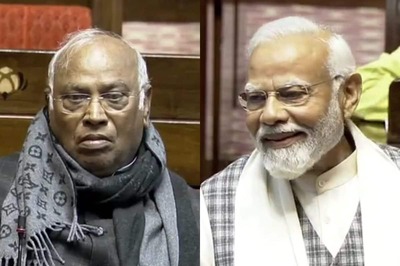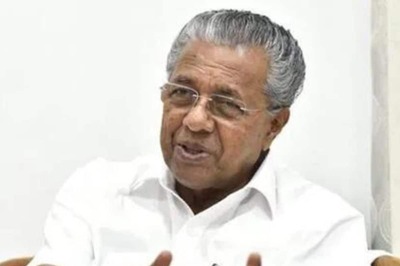
views
The 25 Most Valuable Stamps in the World
British Guiana 1c magenta The British Guiana 1c Magenta is the holy grail of stamps. In 1856, the former British Guiana (now Guyana) post office ran out of stamps unexpectedly. They had to do an emergency run and print their own 1c stamps for newspaper circulation. The stamps are a magenta color with a small image of a boat and the signature of postal clerk E.D. Wright. It’s currently owned by shoe designer Stuart Weitzman. Rarity: Only one known stamp in existence. Price: Sold in 2014 to Weitzman for $9.48 million. While the Mauritius 1d red stamp on a ball cover sold for a higher price, no individual stamp has sold for more than the British Guiana 1c magenta as of January 2025.
Mauritius 1d red Like the coveted Mauritius 2d blue, the 1d red is valuable as part of the first series of British stamps made outside of Great Britain. Issued in 1847 in the former colony Mauritius, the stamp almost immediately sold out. It features a profile of Queen Victoria. Rarity: Only 15 known stamps in existence. Price: Sold on a ball cover (envelope) in 2021 for €8.1 million, or $11.94 million.
500 mon Inverted Centre In 1871, Japan released its first stamp issue, called the Ryumon. One of the stamp sheets featured the mon currency written upside down. This error, combined with the stamp’s age and rarity, contribute to its high value. The only known copy of the 500 mon with an inverted center was found in 1953. Rarity: Only one known stamp in existence. Price: Sold in 2023 for €5.4 million, equivalent to almost $5.8 million.
1c Benjamin Franklin Z Grill At one point, Benjamin Franklin was the U.S. Postmaster general. The most valuable stamp featuring his likeness is the 1c Benjamin Franklin Z Grill, also known simply as the Z Grill. It’s the rarest of all Z grill stamps produced in U.S. history, making it especially valuable for stamp collectors. The New York Public Library owns one, which can never be sold. Rarity: Only two known stamps in existence. Price: Sold in 2024 for $4.4 million. A grill is an embossed pattern on a stamp that allows ink from postage cancellation marks to sink into the fibers of the stamp’s paper, preventing reuse.
Swedish Treskilling Yellow Errors give already rare stamps a boost in value—as is the case of the 1855 Treskilling Yellow. The stamp was supposed to be blue-green, but a printing error created a batch of yellow stamps. While only one is known to exist, up to one hundred potentially circulated and could be hiding somewhere in the world today. Rarity: Only one known stamp in existence. Price: Sold in 1993 for $2.3 million, or $4.428 million when adjusted to 2023 value.
The Sicilian Error of Color In 1859, Sicily issued a 1/2 grana stamp that would go on to become one of the most valuable in the world. While it was supposed to be orange, it printed in blue. The Sicilian Error of Color stamp, which is incredibly well-preserved, features a bearded man looking to one side. Its value is due to its quality, rarity, and color error. Rarity: Only two known stamps in existence. Price: Sold in 2011 for €1.8 million, or $2.6 million.
The Whole Country is Red Amidst the Chinese Cultural Revolution, the People’s Republic of China issued a commemorative stamp designed by artist Wan Wei Sheng. However, the map was deemed inaccurate, as Taiwan was left unshaded and thus could be interpreted as an independent entity from mainland China. Officially, the 1968 stamp was recalled and ordered to be destroyed because of missing islands and inaccurate borders. Rarity: Unknown. At least seven have sold at auction—one regular size stamp and six smaller versions. Price: Sold in 2018 for 13.8 million Chinese Yuan, or $2 million.
15c Abraham Lincoln Z Grill Throughout the 1860s, the US Post Office issued stamps featuring then-President Abraham Lincoln, including after his 1865 assassination. The 1867 issue featuring a portrait of Lincoln and a Z grill (an embossed pattern meant to prevent reuse) is among the most valuable American stamps. Rarity: Only 2 known stamps in existence. Price: Sold in 2019 for $1.6 million.
Baden 9 Kreuzer error In 1851, the former German state of Baden printed a 9 Kreuzer stamp in green ink which was supposed to be used for 6 Kreuzer stamps. Standard Baden 9 Kreuzer stamps are pink. The error, combined with the rarity of this and other pre-World War I and II German stamps, accounts for its high value and desirability among stamp collectors. Rarity: Only four known stamps in existence. Price: Sold in 2008 for $1.545 million. Sold in 2019 for $1.73 million.
Mauritius Post Office 2d blueIn 1847, the British colony of Mauritius issued 500 1d value vermilion red stamps and 500 2d value blue stamps featuring Queen Victoria. Besides being the first government issue of any British colony, the stamps’ limited surviving quantity makes them especially rare. Rarity: Only 12 known 2d blue stamps in existence, and only four unused. Price: Sold in 1993 for SFr.1,725,000, or $1.150 million.
Alexandria “Blue Boy” In 1847, some postmasters made their own stamps because the federal government hadn’t authorized the U.S. Post Office to issue them yet. In Alexandria, Virginia, a postmaster issued several such Postmasters’ Provisional stamps, including at least one printed on blue paper. Rarity: Only one known stamp in existence, although the Alexandria stamps were printed in pairs. Price: Sold in 2019 for $1.18 million. The only known Alexandria “Blue Boy” is on the envelope of a forbidden love letter. The letter’s recipient, Jannett Hooff Brown, was instructed to burn it but didn’t. The forbidden lovers married and had children who rediscovered the valuable stamp in 1907.
Inverted Jenny The Inverted Jenny, an error stamp issued in 1918, is one of the most famous rare US stamps. The stamp is a misprint, as the Jenny biplane at its center is printed upside down. One sheet was sold to collector William T Robey. He notified the post office of the error, prompting them to cease its production. Rarity: 100 known stamps in existence. Price: Sold in 2023 for $2 million. Sold in 1981 for $1 million. While the Inverted Jenny has sold for a higher price than other valuable stamps, it is not as rare as them, affecting its value.
3c George Washington B Grill In 1867, the US Post Office issued a rose-pink stamp bearing a portrait of first President George Washington. Stamps with a B grill are especially rare and therefore valuable. Several grill indentations were used on the stamps, but only a few featured the large B-grill pattern meant to prevent reuse. Rarity: Only four known stamps in existence, all on one 1869 envelope posted from Mason, Texas. Price: Sold in 2008 for $1.035 million.
24c Declaration of Independence with Inverted Center In 1869, the US Post Office issued a batch of stamps featuring a rendering of John Trumbull’s “Declaration of Independence” painting. You likely need a magnifying glass to see all of the 42 figures in the painting, rendered intricately on the tiny postage square. The most valuable version of the stamp inverted the picture. Rarity: Only four known stamps in existence (with the error). Price: Sold in 2008 for $1.2 million.
10c George Washington Green Z Grill US Post Office stamps featuring presidents are coveted for their historical value, particularly if they’re popular presidents like Washington or Lincoln. A 10-cent Green Z Grill stamp issued in 1867 is remarkable for its rare grill (an embossed pattern meant to help prevent reuse by absorbing cancellation ink). On its face: the nation’s first president, George Washington. Rarity: Only 6 known stamps in existence. Price: Sold in 2019 for $1 million.
Red Revenue One Dollar Small In 1897, China issued a small batch of red one-dollar stamps. However, the text was considered too small and the stamps were replaced with another version. With only 32 recorded copies of the 50 produced, the stamp is one of the most valuable Chinese stamps. Their red color symbolizes luck. Rarity: Only 32 known stamps in existence. Price: Sold in 2013 for $6.9 million HKD, or about $890,000 USD.
2 cent Hawaiian Missionaries In 1851, the Kingdom of Hawaii issued its first stamps. They were mostly used by Christian missionaries, earning the nickname “Hawaiian Missionaries.” Because they were printed on thin blue Pelure paper, many deteriorated or were damaged over time. The most valuable are the 2-cent denominations used in newspaper circulation. Rarity: Only 15 known stamps in existence. Price: Sold in 2018 for $619,500.
Olive Queen Victoria’s Head Few if any stamps have as many errors as the olive green Queen Victoria’s Head stamp produced in 1864 in Hong Kong. The stamp was supposed to be a brown gray, but ended up olive green. Its watermark is also incorrect—and there’s a text error, too. Rarity: 40 known stamps in existence. Price: Sold in 2012 for $824,648.
10 Cents on 9 Candareen inverted Between 1894-97, China issued a batch of “Empress Dowager” stamps. None is as coveted as the rare inverted (upside down) surcharged version of the nine-candareen stamp, issued in 1897. The dark-green stamp came out at a time when the Imperial Post Service’s currency was changing away from candareens—thus, the 10 cent surcharge. Rarity: Only three known stamps (with the inversion error) in existence. Price: Sold in 2019 for $6 million HKD, or about $800,000.
Tiflis Unica The Russian Empire issued the Tiflis stamp, also known as the Tiflis Unica or Tiflis Unique, in 1857. The stamp is indeed unique in appearance, featuring an embossed, raised design. Because so few stamps survive from the Russian Empire, this stamp is extra valuable for collectors. Rarity: Only five known stamps in existence. Price: Sold in 2008 for €480,000 or about $700,000.
Inverted Pair Dr Sun Yat-sen In 1941, Hong Kong issued a stamp of Dr Sun Yat Sen, the first president of the People’s Republic of China. However, Sen’s image was inverted (upside down). Officials only made one sheet of fifty stamps containing the error, making it one of the rarest Chinese stamps in history. Rarity: Only four known stamps (two pairs) in existence. Price: Sold in 2018 for $707,700 (one pair).
Penny Red Plate 77 Penny Red stamps are by no means uncommon, but the rare Plate 77 Penny Red is a valuable exception. The British authorities issued only one sheet of 240 stamps in 1864. Because of an error with the plate alignment, the stamps were mis-perforated and too low-quality to be circulated. While most of the stamps were destroyed, a few escaped. Rarity: Only nine or eight known stamps in existence. One may have been destroyed in the 1906 San Francisco earthquake. Price: Sold in 2016 for £495,000, or about $614,000.
Pale Dull Purple I.R. Official In March 1904, Great Britain issued a purple six-pence stamp depicting Edward VII. In May 1904, the stamps were officially withdrawn and ordered to be destroyed. A few survive today, having been used exclusively by the Inland Revenue (I.R.) government department. Rarity: At least six known stamps in existence—along with a mint sheet of 234 and eight other stamps in museums or government collections. Price: Sold in 2010 for £400,000, or about $560,000 when adjusted for 2024 value.
15c Landing of Columbus with Inverted Center In 1869, the US Post Office issued a stamp bearing John Vanderlyn’s painting “Landing of Columbus.” The stamp is already significant for being part of the Pictorial Issue series that diverged from the tradition of depicting leaders. The versions with an inversion error (upside down picture) are even more valuable. Rarity: Unknown, only three unused copies. Price: Sold in 2013 for $800,000.
2c Carmine Vertical Coil Pair, George Washington In 1908, the US Post Office issued the 2c Carmine Vertical Coil pair of stamps. The beautiful carmine color, combined with the stamps’ rarity in the 21st century, makes the duo one of the holy grails for U.S. stamp collectors. Rarity: Only five known stamp pairs (in mint condition with original gum) in existence. Price: Sold in 2019 for $700,000.
How to Tell if a Stamp Might Be Valuable
Find out the stamp’s age and rarity. A stamp that was issued a long time ago is usually worth more than a newer stamp because of its historical significance and potential rarity. Try to identify the stamp online on a stamp auction site or by visiting a stamp appraiser in-person to determine its age and how many are known to exist. One online resource to try is [stampworld.com stampworld.com], which lets you search for stamps by issued country, year, motif, color, denomination, and more. To help identify your stamps, compare your stamp to a stamp catalogue such as The World Encyclopedia of Stamps & Stamp Collecting or a Stanley Gibbons Stamp Catalogue.
Check the stamp’s condition. For your stamp to have maximum value, it should look as close to new as possible. There are several aspects of a stamp’s condition that affect its value, regardless of age and rarity. These are detailed below. Other factors that influence value include the stamp coming from a former country or colony, having a high denomination (and thus being used less), or having a rare error. Being in or close to mint condition Having the full gum (adhesive backing) Having the perforations (edge border) around it in-tact Having no or a light cancellation mark Not being applied to paper Lacking a hinge (a small, transparent piece of paper that sticks it to an album page) Being uncreased
Check stamp values online or at a stamp show. Check out auction websites or online resources like forums, stamp dealerships, or stamp enthusiast sites to determine the possible value of your stamp. Alternatively, attend a stamp show like the Great American Stamp Show to assess the market value of your stamps and talk with other collectors. A popular online stamp resource is the Stanley Gibbons marketplace (for British stamps). Another option is a website like Kenmore Stamp which explains the differences between similar U.S. stamps that vary in rarity.
Seek professional appraisal of your stamps. While you can attempt to identify and valuate your stamps yourself, there are instances where a professional opinion is helpful. These are detailed below. Some philatelic groups, such as Warwick & Warwick in the UK, offer free stamp valuations at their offices. Find local appraisers by searching online for reputable stamp dealers near you. Check that they’re affiliated with a trusted association like the American Philatelic Society or the National Stamp Dealers Association. Get multiple valuations to determine what a fair price for your collection may be. If you have a large collection, get a professional appraisal to save time versus individually identifying stamps yourself. If you’ve inherited a collection, visit a professional stamp appraiser or expert to determine its value and learn selling options to get the highest price possible. If you suspect you have rare or valuable stamps, get a professional opinion. You don’t want to accidentally sell a forgery or reproduction, or mistake a common stamp for a rare one.
How & Where to Sell Valuable Stamps
Contact a specialist auction house. If you believe you have very rare and valuable stamps, or many stamps of different degrees of rarity, get in touch with a specialist auction house. These organizations offer appraisal and auction services to help you fetch the best price for your valuable philatelic items. In the UK, there’s Warwick & Warwick. Another option is Sotheby’s.
Reach out to your local stamp society or dealership. If the stamp or stamp collection you’re trying to sell isn’t extremely rare, an auction house might not be the best marketplace to sell it. Instead, contact your local stamp society or a stamp dealership. Look for businesses affiliated with the American Philatelic Society, the American Stamp Dealers Association, the National Stamp Dealers Association, or whatever group is most reputable in your country.
Use a circuit sales service. The American Philatelic Society (APS) operates a “Circuit Sales” program. If you have an APS membership, you can purchase sales books and mounts to submit your stamps to the APS. You must price and describe each stamp, as well as the stamps’ overall net value. Once you mail a book to the APS, they take over by circulating the book to potential buyers for 18 months. Anything unsold is returned to you.




















Comments
0 comment